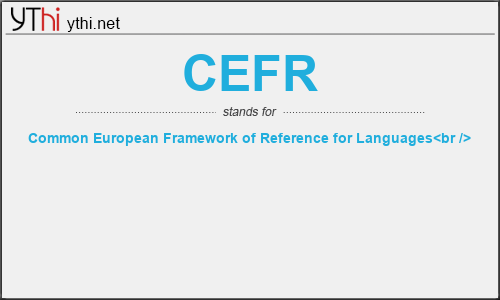What does CEFR mean? What is the full form of CEFR?
The Full Form of CEFR is Common European Framework of Reference for Languages
The Common European Framework of Reference for Languages: Learning, Teaching, Assessment, abbreviated in English as CEFR or CEF or CEFRL, is a guideline used to describe achievements of learners of foreign languages across Europe and, increasingly, in other countries. It was put together by the Council of Europe as the main part of the project “Language Learning for European Citizenship” between 1989 and 1996. Its main aim is to provide a method of learning, teaching and assessing which applies to all languages in Europe. In November 2001, a European Union Council Resolution recommended using the CEFR to set up systems of validation of language ability. The six reference levels (A1, A2, B1, B2, C1, C2) are becoming widely accepted as the European standard for grading an individual’s language proficiency.
The first specification of this “threshold level” was formulated for the English language (Threshold level, 1975), quickly followed by French (Un Niveau Seuil, 1976). These two instruments have been used de facto as models for the same type of reference instruments that were produced subsequently for other languages, but they were adapted to suit the peculiar features of each language.
In order to meet the teaching and certification requirements, the level concept as defined was extended to cover specification of levels lying immediately below and above the threshold level. In the light of the developments in this field, particularly as regards the CEFR, other levels were developed for a number of languages. These proficiency levels constitute one of the origins of the six-level scale of the CEFR.
Launched in 2001, the CEFR marked a major turning point as it can be adapted and used for multiple contexts and applied for all languages.
The CEFR is based on all these achievements and has developed a description of the process of mastering an unknown language by type of competence and sub-competence, using descriptors for each competence or sub-competence, on which we shall not go into further detail here. These descriptors were created without reference to any specific language, which guarantees their relevance and across-the-board applicability. The descriptors specify progressive mastery of each skill, which is graded on a six-level scale (A1, A2, B1, B2, C1, C2).
However, for textbook authors, teachers and other professionals, the specification set out in the CEFR may appear excessively broad, particularly since individual languages are not addressed. The Reference Level Descriptions (RLD) for national and regional languages, which provide detailed content specifications for different CEFR levels, have been developed to address this issue.
CEFR
means
Common European Framework of Reference for Languages![]()
Translate Common European Framework of Reference for Languages
to other language.
,
' on your site.


Leave a Reply
You must be logged in to post a comment.